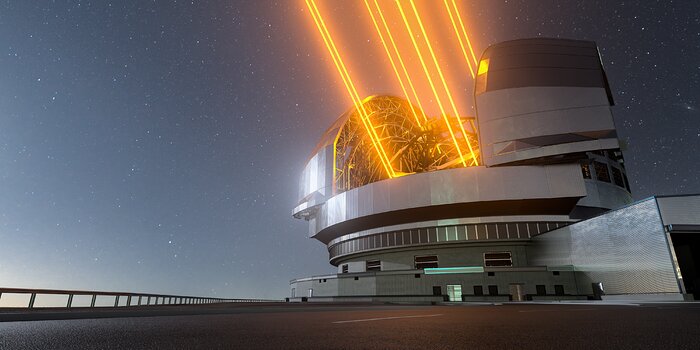Designed for World's Biggest Eye on the Sky
06-05-2021 Delivery of first Guide Star Laser for ESO's Extremely Large Telescope – Executing a contract signed in late 2017 with the European Southern Observatory, ESO, TOPTICA Projects GmbH delivers the first guide star laser system for the Extremely Large Telescope (ELT) that is being built by ESO in the Chilean Atacama desert.
With a tight schedule for the delivery of the remaining lasers (ELT could use up to eight guide star lasers) and “first light” for the telescope itself expected in the second half of the “twenties”, ESO seems to lead the race for the next-generation super telescope.
The guide star lasers for the adaptive optics system on the ELT are based on the laser systems that have successfully operated at the Very Large Telescope (VLT) since 2016 as part of the Adaptive Optics Facility (AOF), which has shown spectacular improvements in image sharpness (eso1824).
Adaptive optics compensate for the blurring effect of the Earth’s atmosphere, enabling astronomers to obtain much sharper images. Lasers are used to create multiple artificial guide stars high in the Earth’s atmosphere. These points of light are used as reference light sources to allow the adaptive optics system to compensate for turbulence in the Earth’s atmosphere. Unlike natural guide stars, laser guide stars can be positioned anywhere to allow the full power of adaptive optics to be used over almost the entire sky. The ELT will employ incredibly sophisticated 'adaptive optics' technologies to ensure its images are sharper than those of any other telescope.
Anticipated observations enabled by the ELT’s powerful built-in adaptive optics system include everything from studying black holes to investigating some of the youngest galaxies in the distant universe.
This image shows an artist's impression, based on the final design for the telescope, of ESO's Extremely Large Telescope (ELT), which will be the biggest ‘eye on the sky’ when it achieves first light later this decade. The telescope uses lasers to create artificial guide stars to measure how much the light is distorted by turbulence in the Earth’s atmosphere. The deformable M4 mirror adjusts its shape in real time to compensate for these changes in the atmosphere, helping the ELT produce images 16 times sharper than the Hubble Space Telescope. Credit: ESO
For details please get in touch:
www.toptica.com/sodiumstar
elt.eso.org
Your contact for press inquiries:
Jan Brubacher
Senior Marketing Manager
Phone: +49 89 85837-123
E-Mail: jan.brubacher [at] toptica.com
TOPTICA Photonics AG
Lochhamer Schlag 19
82166 Graefelfing, Germany
The photos may only be used in editorial material - commercial use is not permitted. TOPTICA Photonics AG must always be named as the source. Please don't hesitate to contact me if you have any questions.

